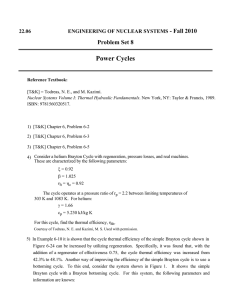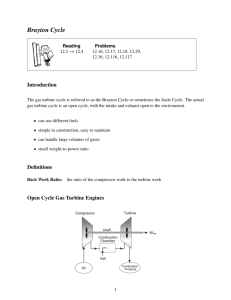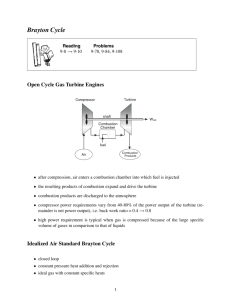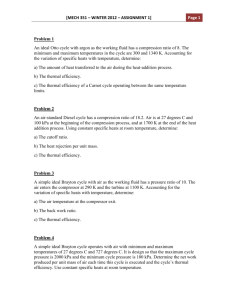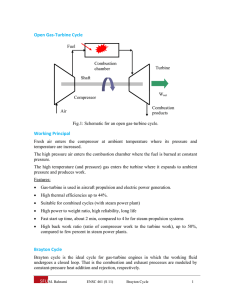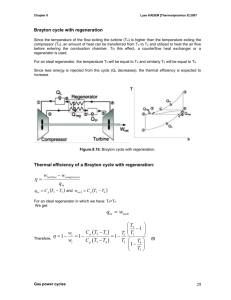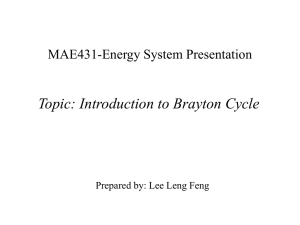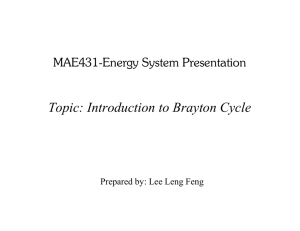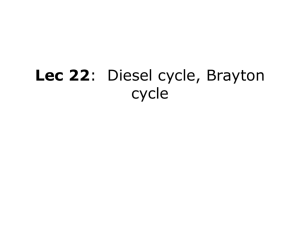BRAYTON Cycle
advertisement
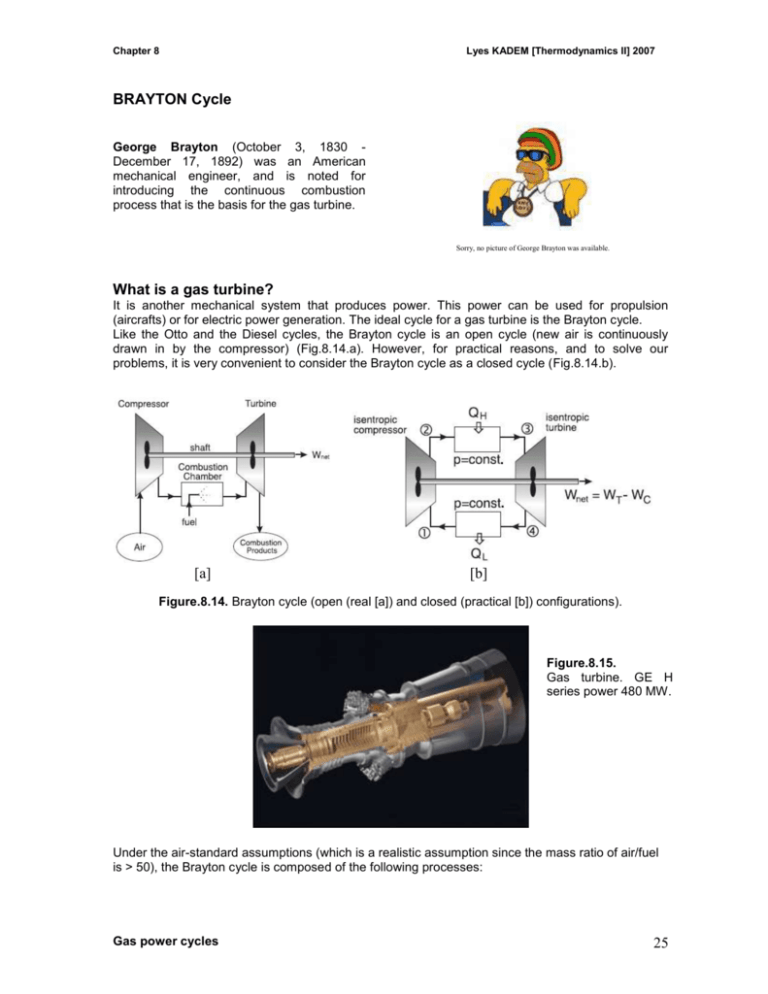
Chapter 8 Lyes KADEM [Thermodynamics II] 2007 BRAYTON Cycle George Brayton (October 3, 1830 December 17, 1892) was an American mechanical engineer, and is noted for introducing the continuous combustion process that is the basis for the gas turbine. Sorry, no picture of George Brayton was available. What is a gas turbine? It is another mechanical system that produces power. This power can be used for propulsion (aircrafts) or for electric power generation. The ideal cycle for a gas turbine is the Brayton cycle. Like the Otto and the Diesel cycles, the Brayton cycle is an open cycle (new air is continuously drawn in by the compressor) (Fig.8.14.a). However, for practical reasons, and to solve our problems, it is very convenient to consider the Brayton cycle as a closed cycle (Fig.8.14.b). [a] [b] Figure.8.14. Brayton cycle (open (real [a]) and closed (practical [b]) configurations). Figure.8.15. Gas turbine. GE H series power 480 MW. Under the air-standard assumptions (which is a realistic assumption since the mass ratio of air/fuel is > 50), the Brayton cycle is composed of the following processes: Gas power cycles 25 Chapter 8 Lyes KADEM [Thermodynamics II] 2007 1-2: isentropic compression 2-3: isobaric heat addition 3-4: isentropic expansion 4-1: isobaric heat rejection [s=cte] [P=cte] [s=cte] [P=cte] Figure.8.16. T-s and P-v diagrams of the Brayton cycle. Brayton cycle efficiency 1 T4 1 C p T4 T1 T T 1 1 1 1 T C p T3 T2 T2 3 1 T2 Qout Qin Using the isentropic relations: k P2 T2 k 1 and P1 T1 k P3 T3 k 1 P4 T4 But P2=P3 and P1=P4; therefore T T2 T3 T or 4 3 T1 T4 T1 T2 Hence, the efficiency of the Brayton cycle can be written under the form: P T 1 1 1 1 T2 P2 k 1 k The ratio P2/ P1 is called the pressure ratio (rp), therefore: 1 k k 1 rp The efficiency of a Brayton cycle is only dependent on the specific heats ratio (k) and the pressure ratio (rp). Rmk: this expression is valid only for a constant Cp Gas power cycles 26 Chapter 8 Lyes KADEM [Thermodynamics II] 2007 How to increase the efficiency of the gas turbine? By increasing the pressure ratio … easy !!!! 0.7 Thermal Efficiency 0.6 0.5 0.4 0.3 0.2 0.1 0 0 5 10 15 Pressure ratio 20 25 Figure.8.17. Increase thermal efficiency of the Brayton cycle by increasing the pressure ratio. OK! Can we indefinitely increase the pressure ratio? Oups ! no. Because, higher pressure ratios lead to a higher maximal temperature (T 3) and this temperature must not exceed the temperature that the turbine blades can withstand (around 1600 K in practice). Furthermore, for fixed inlet and maximal temperatures, increasing the pressure ratio over a certain limit leads to an increase in the thermal efficiency but a decrease in the net work output. Therefore, practical pressure ratios are between 5 and 20. Figure.8.18. Effect of increasing the pressure ratio on the net work. Gas power cycles 27 Chapter 8 Lyes KADEM [Thermodynamics II] 2007 Actual Brayton cycle The actual efficiency of the Brayton cycle is lower than the theoretical value. This is because: 1- The compression and the expansion are not isentropic. Typical compressor and turbine efficiencies are around 85%. 2- The compressor requires a high percentage of work. Typically, between 40-80% of the turbine’s output is used by the compressor, leaving only 60-20% as a useful work. This may seems surprising when we compare this percentage with the one required by the pump for a Rankine cycle (around 1-2%). This can be explained by the fact that in a Rankine cycle the pump compresses a liquid (very small specific volume), whereas in a gas turbine, air is compressed. Numerical example: T1=15°C; P1=0.1 MPa and P2=0.5 MPa 2 Rankine cycle (pump): w p P 2 P1 0.001010500 100 0.4 kJ/kg 1 Brayton cycle (compressor): P T2 w p h2 h1 C p T2 T1 C p T1 1 C p T1 2 T1 P1 k 1 k 0.4 1 1.0035288.2 51.4 1 169 kJ / kg Typical values: 1940s Today efficiency (17%) maximal temperature ~ 540°C efficiency (40%) in simple configuration. maximal temperature ~ 1600°C Example Air enters the compressor of a gas turbine at 100 kPa and 15°C. The pressure at the outlet of the compressor is 0.5 MPa and the maximal temperature of the cycle is 900°C. Determine: 1- The work of the compressor. 2- The work of the turbine. 3- The thermal efficiency. Gas power cycles 28

